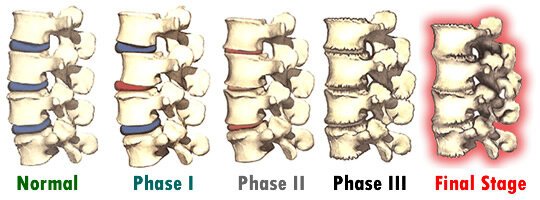The discs between our vertebrae play an important role in our bodily function — they are there to keep your spine mobile and flexible, absorb shock, and support your vertebrae. Over time, spinal discs start to lose their water content and, in turn, their cushion-like support. When this happens, it is known as disc degeneration.
While everyone will experience some sort of disc degeneration as a natural process of aging, not everyone has degenerative disc disease (DDD). DDD progresses over time and can be broken down into four phases. This condition can be caused by daily wear and tear, aging, playing sports, a traumatic injury, or a series of minor injuries.
The Four Stages of Degenerative Disc Disease
What are the stages of degenerative disc disease? Degenerative disc disease can be broken down into four distinct phases:
Stage One: Dysfunction
In the first stage of DDD, you will likely have no pain but may experience occasional discomfort. There may be small changes in your spine’s curvature, which you may or may not notice. The loss of disc volume may affect your posture, energy levels, and the level of strain on your spinal nerves, which accelerates their aging.
Stage Two: Dehydration
In this stage, your spinal discs lose more water and, because of this, some more of their height. You will also likely start to notice further postural changes in this stage. In stage two, you may also start to feel more tired and notice some aches and pains every so often. Many people reach this stage by the age of 40.
Stage Three: Stabilization
Spinal nerve compression, also known as spinal stenosis, typically occurs in this stage. This could be caused by bone spurs, which your body grows to ensure spinal stability, or by postural changes, which are more noticeable in this stage. You may also experience increased tiredness and pain that radiates into your extremities.
Stage Four: Collapsing
In the final stage, known as advanced degenerative disc disease, the disc collapses and herniates. During this stage, the discs are very thin, with only a small portion of them remaining. Your vertebrae may fuse to minimize movement and compensate for the lack of cushion. Your symptoms will depend on where the herniation occurs, but you may experience increased pain along with neurological issues.
Symptoms of Degenerative Disc Disease
Symptoms of degenerative disc disease vary from person to person and will change depending on the stage you are in and the location of the affected discs. Common symptoms of DDD include:
- Pain, which can range from a dull ache to severe
- Pain that gets worse when sitting, twisting, bending, or lifting something, and improves while changing positions often, lying down, or while walking or running
- Periodic severe pain that lasts from a few days to months before improving
- Stiffness
- Fatigue
- Bone spurs
- Pain, numbness, or tingling that radiates into the limbs
- Weakness in the legs
- Foot drop
If you experience severe symptoms, such as incontinence or difficulty walking, seek immediate medical attention. If DDD is left untreated, it can lead to debilitating pain, permanent damage, and other serious side effects, such as paralysis, herniated discs, spinal stenosis, and spinal osteoarthritis.
Get Prompt Treatment for Degenerative Disc Disease With Citrus Spine Institute
Regardless of the severity of your symptoms, you shouldn’t have to suffer. If any of these symptoms sound familiar, schedule a consultation with a spinal specialist. While degenerative disc disease isn’t curable, there are things you can do to find relief from your symptoms and slow its progression. The dedicated team of professionals at Citrus Spine Institute can help you get the answers you need to improve your spinal health and, in turn, your quality of life.
Contact us today to schedule a consultation at our outpatient office in Crystal River, Florida.


